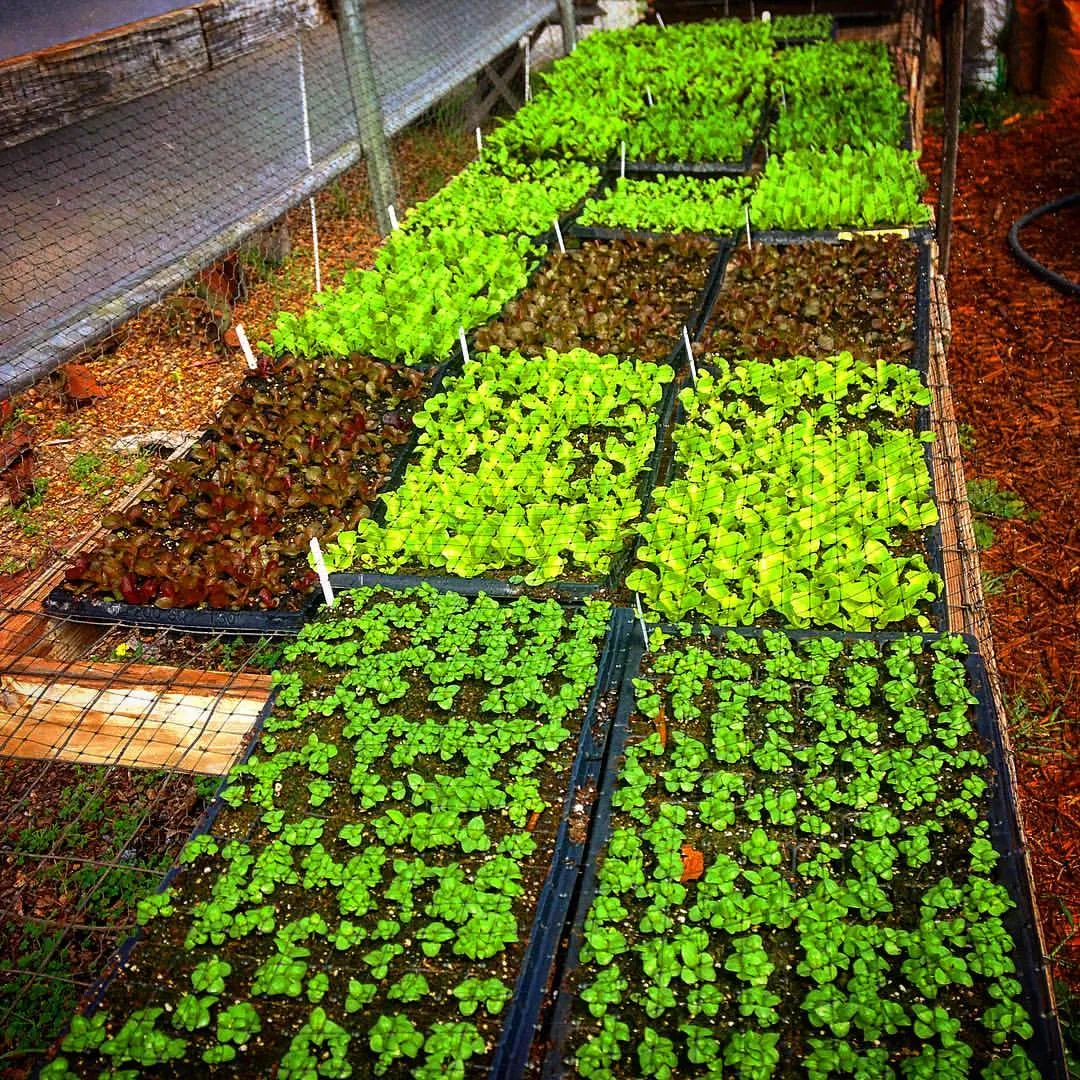Greenhouse Management
Photo credit to Emily Parsons at Everett
Family Farm
Proper greenhouse management is extremely important for the efficiency and health of a farm. It may
seem simple — put a seed in a tray with soil, add water, and voila, there are young plants to
transplant into the field. In theory, yes, that’s all there is to it. But optimal air temperature
and water delivery are crucial for the development of seedlings. Also, hidden in the air all around
us, in the water coming out of a hose, and in the ground inside a greenhouse, there are many
mysterious little life forms ready to wreak havoc on young plants. The three most important
greenhouse management practices are optimal temperature control, consistent air circulation and
proper moisture delivery.
Optimal Temperature Control
Air and soil temperature are widely known to be important for seed germination, but the
specifications for each type of seed are so different it can be hard to manage. For instance,
solanums (tomatoes, eggplant, etc) need an optimum soil temperature of around 90 degrees while
spinach needs an optimum soil temperature of 70 degrees. For tomatoes, if the temperature is too
low, the seeds will remain dormant; for spinach, soil temperature that is too high can cause
thermo-dormancy, preventing germination.
So how does one manage the soil temperatures per specific crops? Generally maintaining the
temperature of a greenhouse in the 70-80 degree range is best for all crops. Proper ventilation and
air circulation help maintain that temperature in warm months. Remembering to open the greenhouse
before it’s too hot and closing it before it’s cool (to keep the heat in) are important practices.
In the winter months, some people use electric or propane heaters to maintain warm temperatures. In
hot climates, shade cloth can be draped over a greenhouse to keep the temperature down if needed.
Managing specific soil temps for different crops can be done using location specific heating mats to
raise the soil temperature or using small shade structures to keep flats cooler on your greenhouse
tables.
In order for all of this to work, don’t forget to purchase quality soil and ambient air
thermometers. If funds are available, purchasing a system that is automatic, where the ventilation
is hooked directly into your thermometer, can make life much easier. Remember to continue checking
in on your greenhouse. Greenhouses are extremely fussy and the slightest changes in sunlight and
wind, or technological difficulties can leave your greenhouse bone dry and seedlings wilted or dead.
Air Circulation
To help maintain temperature and prevent pests of the insect or fungal kingdoms, proper air
circulation is crucial. A greenhouse ventilation system should be made up of low, side-wall and
end-wall vents to allow cool air in, and ridge vents to allow the hot air to exhaust out. Fans in
the end walls and in the ridge are important to circulate the air around the greenhouse as well as
create a slight breeze through the plants, preventing spores and insects from hanging out on small
starts. Air circulation is also important in mitigating excess humidity in the greenhouse that molds
and “damping off” organisms love. “Damping off” organisms are fungal pathogens that will be
discussed in the next section.

Proper Moisture Delivery
Perhaps the most important part of germinating a seed is water. For many reasons, monitoring the
moisture levels of your soil media is extremely important and the optimal moisture needed for
germination may not be intuitive. Seeds need consistent moisture to germinate, but they don’t need
very deep watering. Seeds should be watered on a regular basis just enough to maintain a shallow and
high moisture content in the upper part of the soil media where the seed lies. Allowing the very top
of the soil to dry down occasionally is important in preventing soil borne pathogens.
Once the seed has germinated and emerged, it is important to begin incorporating a consistent
wet-dry swing in your media to both promote drought tolerance for their time in the field and
prevent “damping off” organisms from growing. As discussed, “damping off” organisms are fungal
pathogens that inhabit the soil surface of your seedling flats and trays, often forming a green hard
crust. These organisms can make the stems of seedlings rot and the plants ultimately die.
The depth of the watering is also an incredibly important aspect of moisture management practices
in the greenhouse. Once the seedlings begin to grow, the deeper their roots are. Incorporating
longer and deeper waterings less frequently gives the plants the needed wet-dry swing (especially on
the soil surface) but also promotes good root growth and drought tolerance.
In addition to these three important management practices thinking about soil media as well as
the size and shape of the greenhouse are important in creating an ideal greenhouse environment. Soil
media is important in it’s physical and biological characteristics. Thinking about drainage and
biological activity will help prevent contamination. The size and shape of a greenhouse depends on
the farm and it’s ultimate purpose on the farm. Utilizing these ideal practices will give you
beautiful seedlings that will have a greater success rate in the field.
You can find more information using the Center for Agroecology and Sustainable Food System’s online
publication on propogation.
If you liked this article, and want to see more like it, enter your email in the subscribe box to the top-right of this page and we'll send you new blog articles as we publish them.

Patrick Dunn has been farming for over 9 years and his experience ranges from production
scale market farming to community based urban agriculture. He studied at the Center for
Agroecology and Sustainable Food Systems at UCSC and co-founded Emerald Street Community
Farm and Master Street Farm in Philadelphia, PA. When Patrick isn't farming, you can find
him dangling from ropes high on the granite walls of Yosemite or jetting off to the
mountains for solitude in the wilderness.